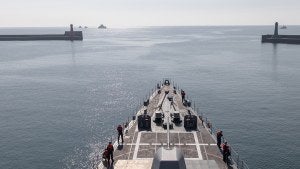How to Best Defend Taiwan

The strategy debate has serious implications for both Taipei and, by association, the United States, argues Ethan Kessler.
At his meeting with President Joe Biden on Monday, Chinese President Xi Jinping called Taiwan the “number one inviolable red line of China-US relations,” echoing his statement at last month’s 20th Chinese Communist Party Congress that Beijing will “reserve the option of taking all measures necessary” to reunify with Taiwan. China’s desire to prevent Taiwan independence and reunify with Taiwan is clear. This desire, along with China’s rising military power, has spurred debate in both Taipei and Washington on how to best defend Taiwan. Some, including Taiwan’s current military leaders, want to stick with Taiwan’s conventional defense concepts: buying a wide range of weapons, including high-end US platforms like fighter jets and tanks, for a wide range of missions. Others want to switch to an asymmetric (or “porcupine”) strategy focused on slowing down Chinese forces with small, distributed weapons, like mobile missiles, mines, and anti-air systems. The outcome of this debate has serious implications for Taiwan’s security and, by association, US national security.
Taiwan’s Conventional Strategy and the Changing Environment
Taiwan’s conventional strategy dates to the Cold War, when Chinese forces were too weak to blockade or invade Taiwan. (Since 1949, the People’s Republic of China has promised to reunify with Taiwan, which was settled by retreating Nationalist Chinese forces in the Chinese Civil War.) Under this strategy, Taiwan has a variety of systems to counter Chinese forces at various distances across the Taiwan Strait. Jet fighters are important for denying air control to China over the Strait. Long-range missiles are key for striking the mainland. Frigates and submarines are needed to counter China’s attempts to impose a blockade; tanks and infantry, to defeat China’s landing forces. Supporters of this approach argue that buying big-ticket platforms also deters Beijing by showing US commitment to Taiwan, but that Taiwan still needs to keep its own air and naval assets in case a blockade (without an invasion) fails to trigger US direct intervention.
However, the conventional strategy is arguably bygone. Beijing has recently commissioned more surface ships and submarines, built more fighters and bombers, and expanded its ballistic and cruise missile arsenals. These capabilities would likely allow it to decimate Taipei’s fighters, frigates, and tanks in the opening days of a war. All of this military growth has been fueled by China’s explosive economic growth and defense spending in the last three decades. The World Bank estimates that Beijing’s defense spending grew from just $9.9 billion in current USD in 1990 to $252.3 billion in 2020, dwarfing Taiwan’s latest defense budget proposal of $19.4 billion.
The Porcupine Alternative
Reformers in Taiwan and the United States see a porcupine strategy as the answer to this gap. Under this strategy, Taipei would stop buying big-ticket items and instead buy many small, relatively cheap, and concealable systems such as anti-ship and anti-air missiles, patrol boats, and mines. These weapons cannot reach out as far as jets, submarines, and large ships, but they could hammer Chinese forces closer to shore while remaining hidden and spread out. By concentrating its efforts in nearby waters and on land, where its defensive advantage is greatest, Taiwan can slow down Chinese forces, buying time for US troops to arrive and help defeat the invasion. A porcupine defense aims to make Taiwan too prickly for Chinese forces to swallow.
Many in Washington support this approach. The Senate recently added $10 billion in fast-tracked arms sales to Taiwan over the next four years in its fiscal year 2023 authorization bill—more than double the $4.5 billion originally proposed. The feeling in Washington that Taiwan needs different kinds of weapons, not just more weapons, is clear. Late last year, Senator Josh Hawley (R-Mo.) introduced the Arm Taiwan Act, which requires that Taiwan make “investments in its asymmetric defenses, [increase] defense spending,” and implement porcupine reforms to qualify for fast-tracked arms. Last December, Sen. Todd Young (R-Ind.) captured the prevailing sentiment in a Senate hearing, saying that “the legacy systems and weapons that Taiwan has relied on in the past are not sufficient, are not adequate, for a robust defense of the island right now.” Assistant Secretary of Defense for Indo-Pacific Security Affairs Ely Ratner replied that this view reflected the positions of both the Trump and Biden administrations.
Prospects for Change
Despite US enthusiasm for the porcupine strategy, efforts to reorient Taiwan’s defense have stalled. This is because supporters of the conventional strategy still dominate Taiwan’s security establishment and Taiwan’s public is unenthusiastic about the sacrifices required by a porcupine strategy, like raised defense spending or reservist requirements. These sentiments make sense: many of Taiwan’s military leaders balk at overhauling their defense for a partner whose commitment is uncertain, and many Taiwanese people simply do not want to think about war.
Whether reformers in Taiwan and the United States will be able to overcome obstacles to changing Taiwan’s defense strategy is uncertain. To track their efforts, look to Taiwan’s future defense budgets, the readiness of its reserve forces, and the arms it buys from the United States.


Related Content
 US Foreign Policy
US Foreign Policy
Washington has started selling arms that serve a "porcupine" defense strategy to Taiwan. Whether Taipei fully embraces this new approach remains to be seen.
 Public Opinion
Public Opinion
Should China invade Taiwan, 2022 Chicago Council Survey data show most Americans would support sending arms but not US troops.
 US Foreign Policy
US Foreign Policy
Does an increasingly aggressive China mean the United States should maintain its posture of strategic ambiguity or adopt strategic clarity?
